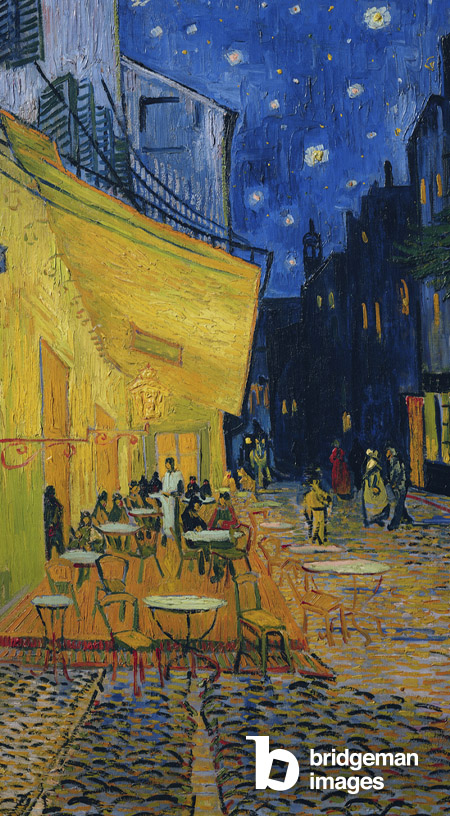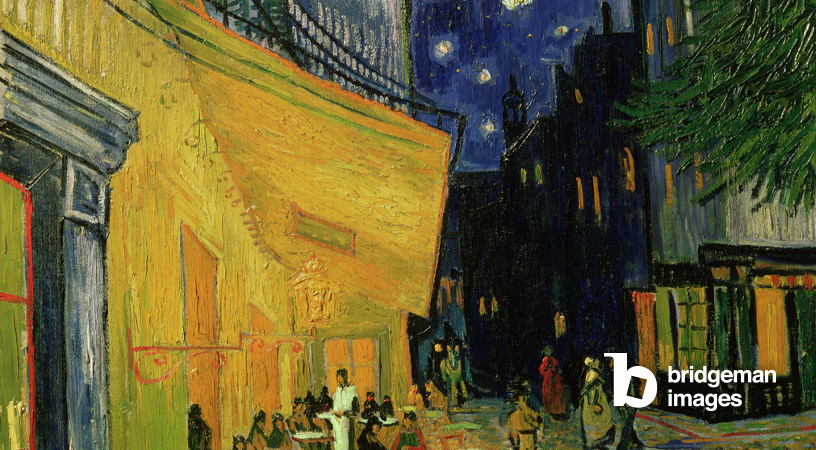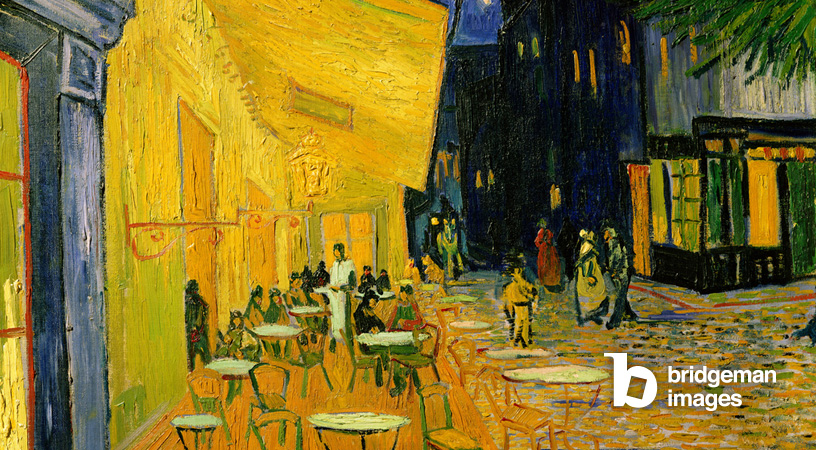Published 26/10/2023
The Café Terrace at Night is a very famous post-impressionist painting. Impressionism was an art movement that emerged in France in the late 19th century. The Impressionists rejected traditional academic painting techniques and instead focused on capturing the fleeting effects of light and colour.
Artists like Camille Pissarro, Claude Monet, Alfred Sisley, Pierre-Auguste Renoir, and others often painted outdoors or en plein air. Their loose brushstrokes and emphasis on light and atmosphere over detail produced hazy scenes that seemed to capture a fleeting moment in time.
The Impressionists held their own exhibitions apart from the official Salon. Initially, their style was controversial, but it became very influential. Impressionism marked a pivotal shift towards modern art.

Who Painted the Café Terrace at Night?
The Café Terrace at Night is an oil painting created by Dutch artist Vincent van Gogh. Vincent van Gogh was a famous Dutch post-impressionist painter who lived from 1853 to 1890. Though he struggled with mental illness and poverty throughout his life, van Gogh produced some of the most influential and recognisable paintings in Western art history.
Known for his vivid use of colour and unique painting techniques, van Gogh created over 2,100 artworks in just 10 years. Some of his most famous paintings include The Starry Night, Sunflowers, Café Terrace at Night, and his many self-portraits.
Originally working as an art dealer, van Gogh decided to become an artist himself at 27 years old with encouragement from his brother Theo. Though he sold only one painting during his lifetime, van Gogh had a huge impact on 20th-century art. His paintings were characterised by dramatic brush strokes, bright colours, and bold contrasts. Unfortunately, he struggled with depression and instability which led him to famously cut off part of his own ear during an episode.
At age 37, van Gogh died by suicide, never knowing the legacy he would leave behind as one of history's greatest artists.
What is the Café Terrace at Night About?
The Café Terrace at Night is an oil painting created by Dutch artist Vincent van Gogh in 1888. It depicts the exterior of a Café in the Place du Forum in Arles, France, where van Gogh was living at the time. The painting shows the Café at night under a starry sky, with a lighted terrace where patrons are dining and a street scene with pedestrians strolling by.
In the foreground of the painting, van Gogh used contrasting colours to highlight different elements - the yellow Café facade, green door and window shutters, and red and blue awnings over the terrace. The street is cast in shadows using blue and green tones while the sky glows with bright whites and yellows to convey the moon and stars. The painting evokes the lively nightlife scene of the Café and captures a quiet, peaceful mood of the night sky.
Overall, the Café Terrace at Night exemplifies van Gogh's post-impressionist style with its visible brushstrokes, expressive use of colour, and depiction of ordinary daily life. It offers a glimpse into nightlife in 19th-century Arles and demonstrates van Gogh's artistic vision in transforming the Café into a captivating night scene.
Why People Love the Café Terrace at Night Painting By Vincent Van Gogh
Vincent van Gogh's Café Terrace at Night is beloved for its mesmerising depiction of a cosy café under the night sky. The scene is lit from within by the warm glow emanating from inside the café, casting a luminous quality onto the patrons' faces. Outside, van Gogh paints the deep blues and violets of the night sky, twinkling with stars. The contrast between the bright interior of the café and the dark exterior creates a captivating interplay of light and shadow.
The scene also evokes a sense of community, as patrons dine together in a public space. There is both separation and connection—while each table keeps to itself, they are all sharing in the common experience. Van Gogh's characteristic brushwork adds to the work's beauty, with each dab and swirl of the brush lending tactile energy and movement. The liveliness suggests that time is passing, though the figures themselves seem frozen in this singular moment. In capturing such an everyday scene, van Gogh elevates the ordinary into something poetic.
The result is an inviting and absorbing work that continues to draw admiration from viewers around the world.
When Was the Café Terrace at Night Painted?
Vincent van Gogh painted this night scene in September 1888, using oil paint on canvas. Prior to painting the Café Terrace at Night, van Gogh had already created many notable works during the decade leading up to his time in Arles. In the early 1880s, while living in the Netherlands, he painted gloomy, earth-toned peasant scenes such as The Potato Eaters (1885). After moving to Paris in 1886, van Gogh adopted the vibrant palette of the Impressionists and painted works like Self-Portrait with Grey Felt Hat (1887).
Also during his Paris period, van Gogh began his famous still life paintings of sunflowers such as Still Life: Vase with Twelve Sunflowers (1888). Other important pre-Arles works include Bedroom in Arles (1888) and The Sower (1888), which already displayed the artist's unique bold, expressive brushstrokes that would characterise his later paintings like the Café Terrace at Night.
The Café Terrace at Night came after van Gogh had already established his distinctive style through years of evolution as an artist, but it marks an important transition in his body of work during his pivotal time in Arles.

Where Was the Café Terrace at Night Painted?
It depicts the exterior of Café Terrace on the Place du Forum in Arles, France. This was a Café that van Gogh frequented during his time in Arles. The Place du Forum is a real public square in Arles, located near the centre of the old town. According to current online sources, there is still a Café located on the northeast corner of the Place du Forum that is a popular tourist destination, though it has changed names and ownership multiple times over the years. Some reviews and articles note that the current Café attempts to recreate the look and feel of the Café depicted in van Gogh's 19th-century painting, though the exact building has undergone renovations.
So, it seems the iconic Café terrace depicted by van Gogh still exists in some form today as a tourist attraction in Arles, though the details have changed over the past 130+ years since the painting was made.
How Long Did It Take to Paint Café Terrace at Night?
Van Gogh began working on the painting in mid-September 1888 shortly after he moved to Arles. It is one of his first paintings produced during his time in Arles.
Van Gogh likely worked on the painting en plein air, sitting outside the Café in the early evening and painting the scene directly in front of him. He used oil paints on canvas for the work. Since the painting depicts the Café at night, van Gogh had to work quickly to capture the scene during the short window between sunset and nightfall. It likely took him between 2-3 sessions in the early evening spread over a few days to complete the work.
The rapid brushstrokes and thick paint application of Café Terrace at Night suggest van Gogh was working diligently to finish the painting before the light disappeared completely each night. He successfully captured the bustling atmosphere of the Café and street scene through brisk, expressive strokes laid down over the course of several evenings. The final painting measures 81 x 65.5 cm, a modest size that also would not have required overly long periods to complete for an experienced, rapid painter like van Gogh.
Why Is the Painting of Café Terrace at Night Famous?
This nighttime scene is one of van Gogh's most renowned works. The painting captures the Café buzzing with patrons on a lovely summer evening. The bright colours and swirling brushstrokes evoke the energy and vibrancy of the scene. The stars glowing in the deep blue sky provide a magical, dreamlike atmosphere. The painting offers a glimpse into van Gogh’s artistic vision and life in southern France. Through this iconic image, van Gogh demonstrates his mastery of colour, light, and post-impressionist style. The beauty and unique perspective of Café Terrace at Night contribute to its fame as a seminal van Gogh masterpiece.
What Did Art Critics Think of the Café Terrace at Night?
During van Gogh's lifetime, his work was not widely appreciated or well-known. He sold only one painting during his career, The Red Vineyard. The Café Terrace at Night was not exhibited publicly until 1892, four years after van Gogh's death. It was shown at various exhibitions in Germany and Switzerland.
Early critics tended to be dismissive or critical of van Gogh's stylistic innovations like his thick application of paint and expressive, visible brushstrokes. Many found his colours garish. Some called the painting "ugly," "crude," and "primitive." Others said it showed technical ineptitude.
It was so radically different from more popular academic styles of the day that critics were unsure what to make of it. While some could see the expressive power in van Gogh's work, it would take a couple of decades before his revolutionary post-impressionist style was more widely appreciated and understood as groundbreaking modern art.
So, in van Gogh's time, the Café Terrace at Night was not well received by many art critics, who found it bizarre and amateurish. But it would eventually be recognised as the innovative masterpiece it is today.
Where is the Café Terrace at Night Painting Exhibited?
Today, this famous postmodern painting is a highlight of the Kröller-Müller Museum's collection in Otterlo, Netherlands, where it has been exhibited since 1962. The museum has one of the largest Van Gogh collections in the world, including masterpieces like The Potato Eaters, Self-Portrait as a Painter, The Sower, and Café Terrace at Night.
The Kröller-Müller Museum also has works by Seurat, Monet, Gauguin, Cézanne, and Picasso. Highlights include Seurat's The Bridge at Courbevoie and Monet's Red Poppies. The museum is known for its outdoor sculpture garden with works by Rodin, Moore, Hepworth, Dubuffet, and many more. Rodin's The Thinker is a notable piece here.
In addition, there are some excellent examples of Mondrian's progression into pure abstraction, like Composition in Line and Colour, a collection of Dutch Old Masters, including paintings by Rembrandt, Frans Hals, Jan Steen, and other 17th-century Dutch artists, as well as modern Dutch artists like Mondrian and Van Doesburg, along with other notable Dutch modernists.
While Van Gogh is a highlight, the Kröller-Müller has an extensive collection representing many eras and genres of art and is well worth visiting if you are in the Netherlands.

The Café Terrace at Night Painting Price
The Café Terrace at Night by Vincent van Gogh has been sold multiple times since it was first painted in 1888. Here are some key details about the ownership and sales of this famous painting.
The painting was acquired by art dealer Johanna van Gogh-Bonger, the artist's sister-in-law after van Gogh died in 1890. In the early 1900s, the painting was sold to a private collector. It passed through several different hands over the next few decades.
In 1938, Café Terrace at Night was acquired by the Kröller-Müller Museum in Otterlo, Netherlands. It has been part of this museum's collection ever since. The Kröller-Müller Museum occasionally loans out the painting for exhibitions around the world. However, it has never been sold by the museum and remains permanently in its collection.
In 1998, the painting was jointly insured for $82 million with van Gogh's Portrait of Dr. Gachet, making it one of the most expensive paintings in the world at the time.
With its striking contrast between the bright lights of the Café and the dark night sky, the Café Terrace at Night painting conveys both the liveliness of a bustling Café scene as well as a feeling of solitude and isolation. The work exemplifies van Gogh's post-impressionist style with its visible brushstrokes and vibrant colours. It is one of his most beloved works.
A selection of our Post-Impressionistic works


